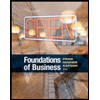
Concept explainers
a)
To determine: Productivity change for Person CL’s bakery in loaves per dollar and with an increase in labor cost.
Introduction: Productivity is a measure of the effectiveness of an individual, systems, machinery and other equipment that are used in converting inputs into outputs. In all organizations, productivity is an important determinant to know cost efficiency.
a)
Answer to Problem 13P
The productivity change with the existing labor force will be 0.293 loaves per dollar and 0.293 loaves per dollar with the new labor force.
Explanation of Solution
Given information: Person CL’s bakery makes 1,500 loaves of bread in a month. Their employees are paid $8 per hour and their total labor hours is 640 hours.
Formula to calculate productivity change:
Determine the productivity change with the existing process:
The productivity change is calculated by dividing the total loaves produced in a month by the result of the total labor hour multiplied to wages per hour.
The productivity change with the existing labor force is 0.293 loaves per dollar.
Determine the productivity change with the new process:
Given information:
Person CL’s bakery increases its productivity to 1,875 loaves of bread in a month. Employees are paid $8 per hour and total labor hours are 800 hours.
The productivity change with the new labor force is 0.293 loaves per dollar.
b)
To determine: The newproductivity change for Person CL’s bakery in loaves per dollar and with an increase in investment.
b)
Answer to Problem 13P
The new productivity for Person CL’s bakery with the existing process is 0.293 loaves per dollar and with the new process being 0.359 loaves per dollar.
Explanation of Solution
Given information:
Person CL’s bakery makes 1,500 loaves of bread in a month. The employees are paid $8 per hour and total labor hours are 640 hours.
Formula to calculate productivity change:
Determine the productivity change with existing process:
The productivity change is calculated by dividing the total loaves produced in a month by the result of the total labor hour multiplied with the wages per hour.
The productivity change with the existing labor force is 0.293 loaves per dollar.
Determine the productivity change with new process:
Given information: Person CL’s bakery increases its productivity to 1,875 loaves of bread in a month. The employees are paid $8 per hour, the total labor hours is 640 hours and an investment of $100 per month is made.
The productivity change with new process is 0.359 loaves per dollar.
c)
To determine: The percentage of productivity change for labor and investment.
c)
Answer to Problem 13P
The percentage of productivity change for labor is 0% and for investment is 22.5%.
Explanation of Solution
Labor:
Formula to calculate percentage of productivity change:
Calculate percentage change for labor:
The percentage change of productivity is calculated by subtracting the initial productivity value from change in productivity value and dividing the result by the initial productivity value.
The change in productivity value is 0.293 (refer to equation (2)) and the initial productivity value is 0.293 (refer to equation (1)).
Hence, the percentage of productivity change for labor is 0%.
Investment:
Formula to calculate percentage of productivity change:
Calculate percentage change for investment:
The percentage change of productivity is calculated by subtracting the initial productivity value from the change in productivity value and dividing the result by the initial productivity value.
The change in the productivity value is 0.359 (refer to equation (4)) and the initial productivity value is 0.293 (refer to equation (3)).
Hence, the percentage of productivity change for investment is 22.5%.
Want to see more full solutions like this?
Chapter 1 Solutions
PRIN.OF OPERATIONS MANAGEMENT-MYOMLAB
- Agree or disagree with post On the surface, the numbers in financial statements do present a snapshot of a company's financial position and performance. However, just looking at the raw numbers often doesn't tell the whole story or reveal underlying trends and relationships that are crucial for making informed decisions. Think of it like looking at individual pieces of a puzzle. Each number is a piece, providing some information. But to see the complete picture – the company's overall financial health, its performance over time, how it compares to its peers, and its potential future – you need to assemble those pieces using different analytical tools. For example: Horizontal analysis helps us understand how specific financial statement items have changed over multiple periods. Is revenue growing? Are expenses increasing at a faster rate than sales? This reveals trends that a single year's numbers wouldn't show. Vertical analysis allows us to see the relative size of each item within…arrow_forwardWhat can you do in response to an insulting offer?arrow_forwardAgree or disagree with post If someone hits you with an insulting offer, the first thing to do is not take it personally. It’s normal to feel a little offended, but blowing up or shutting down won’t help your case. Better move is to stay calm and treat it like a misunderstanding or just the first step in the conversation. That way, you keep things respectful but still let them know the offer doesn’t sit right with you. It also helps to back up your response with facts. Bring in things like your experience, numbers, or any specific results you delivered. That can shift the conversation away from feelings and toward the value you bring. Agree or disagree with postarrow_forward
- Agree or disagree with the post When you get an insulting offer, the best thing to do is stay calm and professional. Try not to take it personally or react out of anger. Instead, ask questions to understand why the offer was so low. This helps you get a better idea of what the other person is thinking. After that, you can respond with a counteroffer that shows your value. Use simple facts like your skills, experience, and what others in your field are getting paid to back up your request. If the person still refuses to offer something fair, it’s okay to politely say no and walk away. Standing up for yourself in a respectful way shows confidence and helps others take you seriously. Agree or disagree with the postarrow_forwardRegarding perceptions that can occur when negotiating in different places and at different times, the continuation norm in e-negotiations is best described as _____. Group of answer choices A. negotiators' beliefs that negotiations are worth continuing B. the act of thinking about how things might have turned out differently C. the tendency for e-communicators to ascribe diabolical intentions to the other party D. the tendency for negotiators to behave as if they are communicating synchronously when in fact they are notarrow_forwardIn any discussion or meeting, there is a tendency for a minority of people to do most of the talking. A key determinant of who dominates the conversation is _____. Group of answer choices A. their status within the group B. their network of social connections C. their gender D. their agearrow_forward
- With regard to intergenerational negotiation, the _____ generation has vast numbers of relationships but few of them are deep. They spend more time communicating virtually than face-to-face. Their personal and work networks are vital to their on-the-fly learning and problem-solving skills. Armed with tools for working anywhere at any time, this generation puts more value in leading a balanced life and flexibility with their work and life demands. Group of answer choices A. mature B. boomer C. millennial D. Generation Xarrow_forwardIf a negotiator has less power than the counterparty and an unattractive BATNA, which communication medium might help the less-powerful negotiator claim more resources?arrow_forwardCould you help explain what the foundations of faith are? What are their strategies?arrow_forward
- Hi! Can you guys help me with this? Thank you! Please write-up summarizing the core message of the movie/documentary and the connection to the course material The documentary is Poisoned: The Dirty Truth About Your Food directed by Stephanie Soechtig from Netflix. * Here are the course material: Global Logistics Global Transportation; Global Inventory Management Global Operation Global Market Channels Purchasing Stategies: Outsourcing; Offshoring; Nearshoring; Multi-sourcing & Co-sourcing Make or Buy decisions Global Supply Chain Infrastructure: Transportation Infrastructure; Communication Infrastructure; Utilities Infrastructure; Technology Infrastructure Supply Chain Risks: • Supply Risks – disruption of supply, inventory and schedules. • Operational Risks – breakdown of operations, changes in technologies. • Demand Risks – variations in demand.• Security Risks – theft, sabotage, terrorism, counterfeiting.• Macro Risks – economic shifts, recession, wage hikes, varying…arrow_forwardHi! Can you guys help me with this? Thank you! Please write-up summarizing the core message of the movie/documentary and the connection to the course material The documentary is American Factory by Steven Bognar & Julia Reichert from Netflix * Here the course material: Global Logistics Global Transportation; Global Inventory Management Global Operation Global Market Channels Purchasing Stategies: Outsourcing; Offshoring; Nearshoring; Multi-sourcing & Co-sourcing Make or Buy decsions Global Supply Chain Infrastructure: Transportation Infrastructure; Communication Infrastructure; Utilities Infrastructure; Technology Infrastructure Supply Chain Risks: • Supply Risks – disruption of supply, inventory and schedules. • Operational Risks – breakdown of operations, changes in technologies. • Demand Risks – variations in demand.• Security Risks – theft, sabotage, terrorism, counterfeiting.• Macro Risks – economic shifts, recession, wage hikes, varying exchangerates.• Policy Risks –…arrow_forward1) View the video Alton Bridge (12.16 mins, Ctrl + Click on the link), and please answer the following questions: https://meida.gaspar.mheducation.com/GASPARPlayer/play.html?id=24qHEm8aNZExFciJtZQbqli a) According to the video, what are the various steps involved in managing projects? b) What were the different phases of the Alton Bridge project? c) What are the two widely used scheduling techniques, and under what phase of the Alton Bridge project are they discussed? Note: As a rough guideline, please try to keep the written submission to a paragraph or so for each of the questions. 2) The following is a table of activities associated with a mining project at Lunar Industries, their durations, and what activities each must precede: Activity Duration (weeks) Precedes A (start) 1 B, C B 1 E C 4 F E 2 F F (end) 2 - The AOM project diagram is as given below: a) What is the critical path (list all activities in the…arrow_forward
 Management, Loose-Leaf VersionManagementISBN:9781305969308Author:Richard L. DaftPublisher:South-Western College Pub
Management, Loose-Leaf VersionManagementISBN:9781305969308Author:Richard L. DaftPublisher:South-Western College Pub Foundations of Business (MindTap Course List)MarketingISBN:9781337386920Author:William M. Pride, Robert J. Hughes, Jack R. KapoorPublisher:Cengage Learning
Foundations of Business (MindTap Course List)MarketingISBN:9781337386920Author:William M. Pride, Robert J. Hughes, Jack R. KapoorPublisher:Cengage Learning Practical Management ScienceOperations ManagementISBN:9781337406659Author:WINSTON, Wayne L.Publisher:Cengage,
Practical Management ScienceOperations ManagementISBN:9781337406659Author:WINSTON, Wayne L.Publisher:Cengage, Purchasing and Supply Chain ManagementOperations ManagementISBN:9781285869681Author:Robert M. Monczka, Robert B. Handfield, Larry C. Giunipero, James L. PattersonPublisher:Cengage LearningMarketingMarketingISBN:9780357033791Author:Pride, William MPublisher:South Western Educational Publishing
Purchasing and Supply Chain ManagementOperations ManagementISBN:9781285869681Author:Robert M. Monczka, Robert B. Handfield, Larry C. Giunipero, James L. PattersonPublisher:Cengage LearningMarketingMarketingISBN:9780357033791Author:Pride, William MPublisher:South Western Educational Publishing





